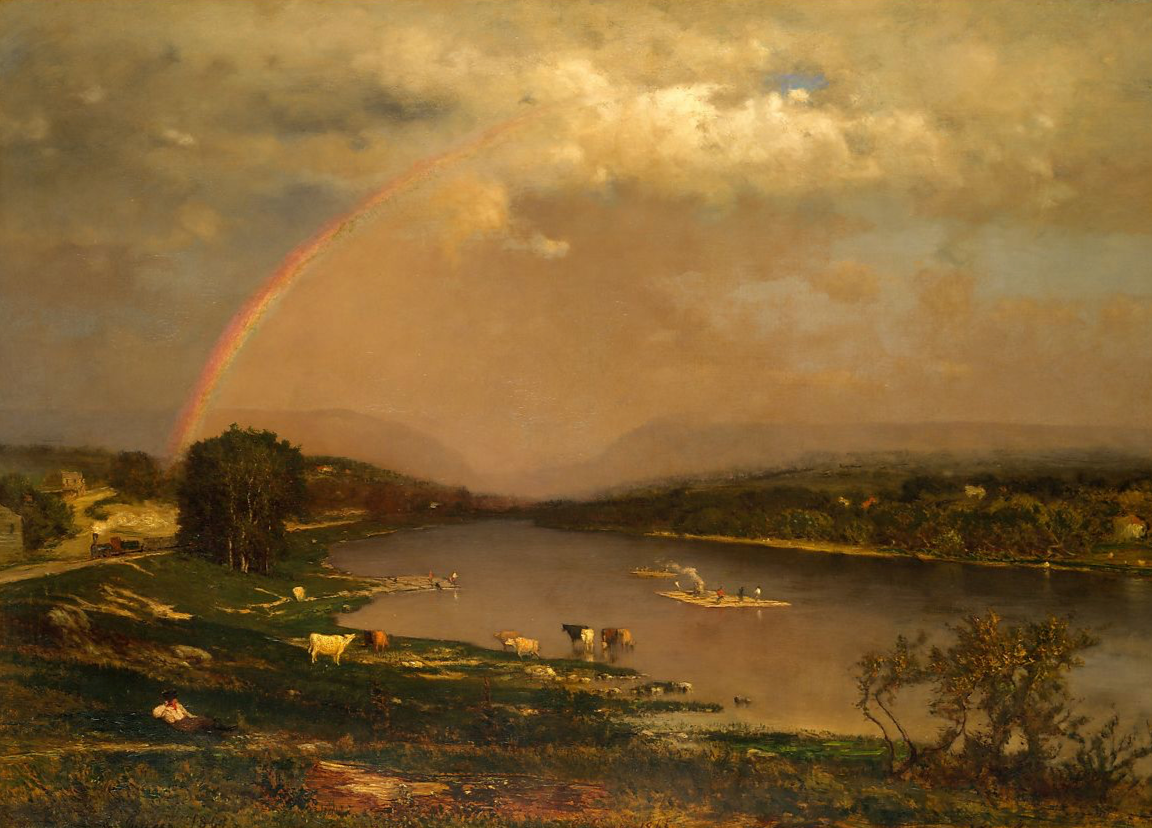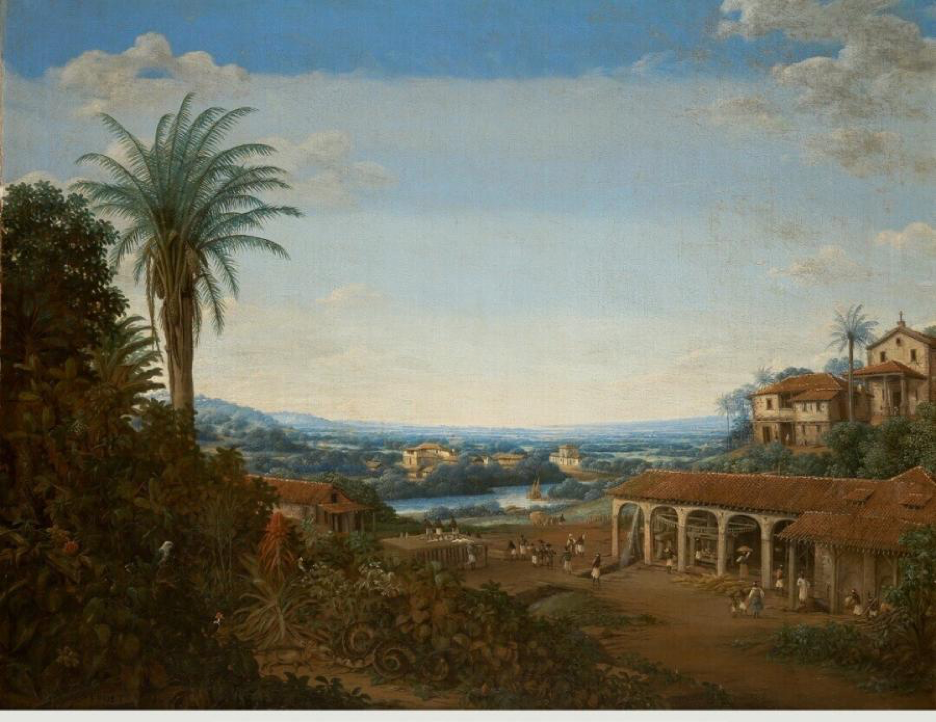
Colonialism and Landscape
The Wrongly Romanticized History Behind Early American Landscape Paintings
When glancing at a landscape painting depicting American scenery, what is the first thing that catches your eye? Is it the rich hues showing scenes of verdant forestry or sparkling streams? The light paint strokes used to create wispy clouds and tall trees? More often than not, we, as viewers of art, tend to enjoy the aesthetics of a piece before knowing the story behind what we are looking at. It is natural to enjoy these paintings for what they are at face value; it can be easy to miss the meanings and histories behind the canvas. This can be espeically true of the way we view American landscape paintings. We often enjoy the talent of the artists and their creations before we understand the scenes depicted.
Nineteenth-century landscape paintings were often romanticized depictions of the American landscape. These paintings did not always directly address how American land was acquired, but instead were often part of a broader cultural narrative that minimized or just ignored the darker realities of colonization, including the forced displacement and violence against Native communities. I intend to argue that early American landscape paintings are poor representations of the serenity and peace they depict. By analyzing George Inness’s nineteenth-century painting Delaware Water Gap and the history of the land it portrays, I will demonstrate how early American art served to obscure the harm and suffering inflicted upon Indigenous groups during the nation's westward expansion.

Fig 1. Inness, George. Delaware Water Gap. 1861. Oil on canvas. The Metropolitan Museum of Art, New York.
Delaware Water Gap (see fig. 1) was completed by George Inness in 1861. It is one of several views Inness painted of this river area, many of which share the same title. (Though he painted numerous works titled Delaware Water Gap, this specific painting should not be confused with Inness’s other depictions of the same location.) Inness used oil on canvas for this piece, with the oil paint allowing for a textured look in the clouds and the greenery.
The Delaware Water Gap is a natural water passage formed by a river cutting through mountain ranges, spanning from the Kittatinny Mountains to the west in Pennsylvania and the Pocono Mountains to the east in New Jersey. The region began to be settled by European colonists in the mid-1700s, particularly after the Treaty of Paris (1763), which ended the Seven Years' War and opened up more land for British settlement. This growth of the area continued through the 18th and early 19th centuries as part of the broader territorial development following American independence won in 1783.
During the period of American expansion, landscape painting was a common tool for artists to portray the potential of the land beyond settlers' homes. The UK National Gallery notes that "in the 1850s, much of the American landscape was still unknown to European settlers. Inness gives it a distinctly European look to suggest fertile land that can be easily inhabited and cultivated," describing the landscape as "tranquil and domesticated" (National Gallery). For Inness and other landscape painters, romanticizing these scenes was crucial, as it depicted the land as calm and inviting, thereby encouraging settlers to partake in the expansion of the new nation.
Inness accomplishes a peaceful and romanticized scene within Delaware Water Gap by portraying nature as inviting and friendly. The focus of the painting is on both the river, used for travel and trade, and the fertile, green land beside it. On the land, a lush grassy area hosts grazing cattle. Humans are depicted both on the grass and aboard a barge floating down the river. Both the frolicking humans and animals give the impression that this is very inviting, tranquil place. The mood they create seems to beg their audience to join in on a peaceful life in these newly settled territories.
This peacefulness is matched by the nature surrounding the animals and humans. Most prominently, a rainbow surrounded by soft, wispy clouds arches over the scene. This serves as a sign that rain has just passed, a storm has just blown over. The curve of the rainbow guides the viewer’s eyes upwards to a light breaks through the clouds, a sign that the sun is gracing this area with its light and basking it in a warm glow. This further enhances the serene environment by showing just how inviting the land is.
In Cultural Contact and the Making of European Art since the Age of Exploration, Julie Hochstrasser offers us perspective about the correlation of landscape paintings and colonialism in her chapter Remapping Dutch Art in Global Perspective. Hochstrasser discusses the obscured truth of Dutch colonialism in Dutch landscape paintings and offers fresh insight into how these paintings hide the painful truth of European imperialism. By using the specifics of Dutch art during mainly the sixteenth and seventeenth centuries, Hochstrasser discusses the ways in which the culture’s art mainly reflected the glorified aspects of the culture during this time, such as expedition and trade. While it is important to reflect the positive aspects of one’s culture, Hochstrasser notes that this often omits the negative actions the Dutch were engaging in when interacting with other cultures.
When discussing the historical study of Dutch art, Hochstrasser states, “Most studies of Dutch art have, until recently, focused on themes and issues indigenous to the Dutch Republic on its home shores" (Hochstrasser 43). With this, Hochstrasser points out how the focus of Dutch art scholarship has largely been Eurocentric, primarily concentrating on themes familiar to European, particularly Dutch, audiences for easy and comfortable consumption. This narrow focus in the schloarship of Dutch art often overlooked or minimized the depiction of uncomfortable or less-palatable subject matter, such as the representation of colonialism or non-European subjects. To illustrate this, Hochstrasser references The Sugarmill (see fig. 2), painted in 1653 by Frans Jansz Post.

Fig 2. Post, Frans Jansz. The Sugarmill. 1653. Oil on canvas and panel. Museum Boijmans Van
Beuningen, Rotterdam.
Hochstrasser explains, “Landscapes Post painted included sugar mills in scenes that are sun drenched, sleepy, and almost pastoral in feeling. But this is impression is radically at odds with the real facts of sugar plantation” (Hochstrasser 56). The reality of these sugar mills included “perpetual violence and warfare” and “entailed the large-scale importation of slaves from West Africa to the Americas” (Hochstrasser 56). While at first glance The Sugarmill seems to be a harmless painting depicting an idealized scene of European expedition and trade, there is a darker truth not made explicitly clear. Instead of showing the harsh realities of Dutch hegemony in Brazil on this plantation, the painting presents the scene from a Eurocentric perspective, focusing on the positive image the Dutch wanted to project of themselves and their actions, ignoring the harm caused by their presence in the region. This is not because settlers believed themselves to be committing wrongdoing, but rather because they were primarily interested in seeing subjects that looked like and pertained to themselves.
This idea is not unique to just the Dutch. Using Hochstrasser’s perspective about landscape paintings can allow us to analyze art of all settler cultures more critically. Hochstrasser’s idea that a culture’s art can omit much of what happens behind the scenes because of intended audience preferences can also be applied to early American art, particularly art from the American colonial period. While American landscape paintings can offer seemingly harmless depictions of beautiful scenery, they often fail to represent the violent colonial history inflicted upon the Indigenous peoples of America with the arrival of European colonizers.
There were three distinct native groups indigenous to the land surrounding the Delaware Water Gap at the time of Inness’s painting: the Lenape, the Jerseys, and the Munsee (Becker 116). Like many other tribes, colonization harmed these groups, forcing their displacement from their native lands to make room for American expansion and development. In the Fort Pitt Treaty of 1778, signed during the American Revolution between the newly self-declared United States and indigenous peoples in Delaware, the United States made several agreements with the Lenape (Delaware) Nation. Among what this treaty called included promises of perpetual peace, forgiveness of grievances, allyship and military aid against the British, and recognition of Lenape sovereignty (Zotigh).
However, this treaty was unsuccessful, with the United States failing to provide promised goods and to prevent settlers from occupying Lenape land ("1778 Treaty of Fort Pitt"). According to the official organizational website of the Delaware (Lenape) Tribe, the indigenous groups were pushed away from their homelands and forced to leave because of the “misleading treaty agreements and the threat of military force,” resulting in these groups “[abandoning] their remaining homelands and [moving] west” (“Removal History…”). Furthermore, in the early 1790’s, the United States “launched a series of military operations to crush [Native] resistance” (Ostler 591). The indigenous Delaware (Lenape) groups, as well as all other Native American groups, were not treated in the ways their treaties promised they would be.
This violence took place about sixty years before Inness painted Delaware Water Gap, but the violence continued on as American expansion and development kept pushing west onto the territories the indigenous groups were forced to flee to. However, this cannot be seen through the vibrant, dreamy colors of the Inness’ Delaware Water Gap. The broken promises of peace and friendship stand in stark contrast to the idealized tranquility Inness depicts. The land is shown, but the horrors that occurred on the land and to the people indigenous to the land are not. Just as Hochstrasser comments on how Post creates a “sleep” and “pastoral” feeling inThe Sugarmill for the Dutch (Hochstrasser 56), covering the fact that the work making these plantations successful was being done by enslaved Brazilians, Inness creates a peaceful feeling for Americans to romanticize. From the arching rainbow to the people and animals lazily grazing, the soft, dream-like atmosphere offers no hint of the violence and betrayal the land once saw.
While landscape paintings may beautifully capture nature, they often veil deeper cultural truths beneath their serene surfaces. In the context of early United States history, these landscapes obscure the horrors that unfolded on these very lands, presenting them instead as idealized territories ripe for American taking. Through an analysis of George Inness's 1861 Delaware Water Gap and the history it portrays, I have argued that early American landscape paintings fail to truly represent the tranquility they depict. Instead, they serve as a canvas for Eurocentric settlers to mask the harm and suffering inflicted upon Indigenous groups, concealing the darker truths of colonization beneath a facade of patriotic beauty.
While we may feel shame for the history of our early nation, it is crucial that we do not erase the truth, that we do not cloak the bloodshed with comforting lies. For our nation to truly progress, we must confront the harm we have caused and take deliberate steps toward healing. Nature may indeed be as serene and beautiful as the artists once portrayed, but that serenity requires effort; it demands a collective will to right the wrongs that have long endured. ✧

Post a comment